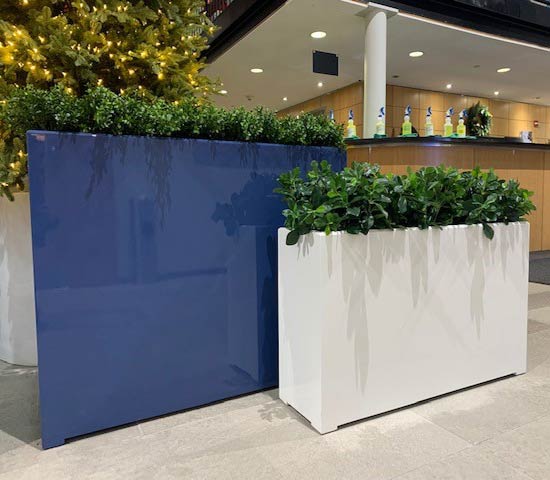
Indoor Planters vs Outdoor Planters
There are a number of reasons that you might want to have planter boxes that can be used indoors and or outdoors but there are several issues you will have to deal with primarily centering around the watering and drainage of your planters. Outdoor planters and indoor planters have completely different watering needs and strategies. Outdoor planters are open to the elements such as rain and will need good drainage to keep the boxes from over watering; indoor planters are quite the opposite. Often they will have no drainage and will need ways to manage overflow.
Outdoor Planters
Plants outdoor often die from underwatering. This is because outdoor planters are subject to rainfall and other precipitation that can cause over
watering if the excess water does not have a place to drain. If this happens the planters will fill up with water and cause root rot which will result in plant and flower death. Use planters with drain holes outside to prevent excess water from harming your plants. The watering frequency for outdoor planters is usually every 2-3 days unless your planters are in direct sunlight most of the day in which case you may need to water daily. A good solution for outdoor planters is to add a
self watering reservoir or watering device either on a timer or connected to a drip line or sprinkler. Self-watering window boxes and planters are becoming more and more common to help deal with the watering maintenance needs to keep flowers alive during the spring and summer seasons.
Outdoor planters generally need to be made from heavy duty materials like PVC, composite, resin, or cement. These are materials that can resist the elements and rotting process. We specialize in composite PVC planters due to our ability to easily customize the size of the planters to our customers needs. Also, PVC is a 100% water proof and rot proof material that performs extremely well in different climates making it very versatile in its use and ability.
Indoor Planters
Unlike outdoor planters which you will water heavier but less often, indoor planters should be watered lighter and more often, typically every day. Indoor planters
will only receive water when you manually water them, so they can be subject to
neglect if you forget to water, but need to be watertight so they do not leak
and cause damage to their surroundings. By watertight, I mean that the planter should not have drain holes or seams that leak. If a planter cannot be ordered without drain holes, then ask the manufacturer if their planters have saucers or drip pans that can be used underneath as a catch to keep your floors from being ruined. A saucer can help you monitor watering levels which can tell you whether you should stop watering or water more. Often if you overwater you may not realize it, until the plants begin to suffer and turn brown or begin to die. Although its possible the plants are not getting enough sunlight, more times than not they are being overwatered.
Indoor planters are commonly made from wood, vinyl, plastic, and fiberglass. The need for a custom planter size is much lower when trying to fill an indoor space. For this reason materials like fiberglass and molded plastics offer a cost effective solution and perform very well in climate controlled areas where there is not a lot of contraction and expansion from heat and cold weather. Pots and plastic liners also work well as being affordable and completely sealed.

Planters on WheelsPlanters with wheels give the flexibility to roll planters outside and inside depending on the season. Keep in mind, however, that if a planter has drain holes for outside, it will definitely need a drip pan to catch the drainage when it's rolled inside for use.
Plant Ideas for both Indoor and Outdoor
Plants
that you might want year round and could be conducive to moving back and forth
might center around food plants; fresh herbs, peppers, and tomatoes can add a
dynamic impact from a small investment. Easy to handle herbs would include
Basil, Oregano, Rosemary, Thyme, Parsley, Cilantro, Chives, and Sage. You can
grow a variety of smaller peppers in sweet and or hot flavors. Smaller tomatoes
like Cherry or Roma can be kept in smaller planters with a climbing cage. These
three varieties of plants can be maintained within 10 minutes or less a day and
be ready to go at a moment's notice to take your food to the next level. Other
people just want to add color, and natural fragrance, or even an air
purification aspect to their homes. For this there are a number of plants for
the first time plant parent and the expert horticulturist alike just be careful
and do your research, as many of them are not pet friendly.
 About the Author About the Author
Matthew Buquoi is the owner of Flower Window Boxes, Inc., which is one of the largest online window box companies in the United States. In addition to being the owner, he is also an expert author, and regularly writes about industry topics in the window boxes, planters, exterior shutters, and home and garden industry.
|
|